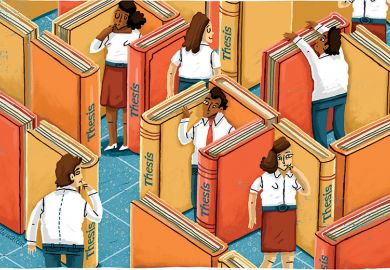What is it exactly that a mentor transmits to a trainee? The question is of vital importance to researchers around the world. These scholars have all undergone years of training and many will go on to mentor new generations of researchers themselves. Being able to track and analyse these academic relationships will go a long way to answering this question and also help to identify the conditions that lead to successful and productive researchers.
But academic mentor and trainee relationships quickly become complicated, especially considering that many students have multiple graduate and postgraduate mentors. In an attempt to better visualise the connections, Stephen David, associate professor of otolaryngology at Oregon Health and Science University, created The Academic Family Tree, a non-profit project designed to present this information in an intuitive “family tree”, like those used by historians, genealogists and life scientists, to distil an otherwise sprawling mass of relationships into a more easily digestible format.
As with similar trees in history and the life sciences, documenting these relationships in a series of interconnected branches can reveal numerous insights that might otherwise have remained hidden or, at least, been rather difficult to see. An academic family tree can help trace the life cycles of various ideas, theories and techniques, as well as identify areas of overlap between academic disciplines.
Moreover, a more thorough understanding of these relationships can help to clarify and examine the conditions that best foster the development of the next generation of academics and, ideally, to see what conditions make for the most successful and productive academics down the line.
That is why a number of disciplines, such as primatology and mathematics, have chosen to publish their own mentorship information in some form. The Academic Family Tree aims to provide a more comprehensive tree, with a “canopy” of overlapping trees of different disciplines.
“What are you actually learning when you work with someone?” Dr David asked. “We’re hoping to find out what is it that’s actually transmitted from mentor to trainee…what are the predictors of success?”
The tree, at the time of writing, had around 715,000 entries, split across some 61 fields, including neuroscience, linguistics, computer science and law. The website asserts a growth rate of “about 360 people per week”. Through linking with other databases, the tree also includes each researcher’s publications, including abstracts, and there are plans to incorporate information on the grants and funding awarded to individuals.
The Academic Family Tree was not always as vast as it is today. It began life in 2005 as a mere sketch on the back of an envelope, an attempt by Dr David, then a graduate student, to understand why members of different labs approached their work and reported findings in different ways.
“We were [in a lab meeting] going through a list of papers trying to understand why one lab said one thing and this other lab another thing,” Dr David said. “We started tracing out relevant players in the debate to see where they were coming from.”
But before long it became clear that such an endeavour was well beyond a quick back of an envelope calculation. It soon “turned into a tangled mess of interconnections…it inspired us to put it online so we could visualise these connections ourselves.”
Once online, the tree grew organically. First, it was Neurotree, a specialised tree documenting the training relationships within neuroscience. As this field is relatively new and draws heavily on a multitude of other disciplines, such as biology, physics and linguistics, the tree quickly grew beyond the confines of neuroscience. “There’s been a little bit of a snowball effect,” Dr David said.
The nature of the tree makes it easy to add entries and scale up. Dr David soon received requests for help in establishing and incorporating other academic genealogies. “I’d get emails saying things along the lines of, ‘Hey, that’s nice for neuroscience – why can’t we have one for, say, chemistry?’” he said. Professional organisations also showed interest in the project. They “see it as a chance to aggregate information about their fields”. One professional organisation even included data collection for the project as a part of its annual conference.
The project is open and collaborative by nature, said Dr David, and anyone can contribute. “It’s really just someone taking time to provide data,” he explained. “I probably spent far more time than I should have putting data into the database as a grad student.”
Beyond being a useful tool for visualisation, the data held in the tree are a veritable treasure trove of information. And the tree has revealed some really interesting family connections as it has grown. The physiologist Ivan Pavlov is, for instance, the academic “cousin” of pioneering psychoanalyst Sigmund Freud, via the scientist Johannes Peter Müller; around 62 per cent of neuroscientists on the tree today can trace their lineage back to just one person; and some individuals can even trace their family all the way back to the beginning days of the university.
“You’ve got these figures from the Middle Ages and way back there,” said Dr David. This isn’t necessarily a sign of influence, he cautioned, but it’s still interesting to note. “Do they have anything to do with science now or did they just happen to be the ones who trained monks in monasteries? It’s unclear what has been transmitted here.”
There’s also an interactive element for those on the tree: interested individuals can log on to see who their closest Nobel prizewinning “relation” is. “Everyone’s always pretty close [to a Nobel laureate],” Dr David said. “It’s one of those properties of networks that you don’t appreciate until you look at the data.”
Not everyone is convinced about the merits of academia’s flirtation with genealogy. Writing in Times Higher Education in 2010, Jon Adams, a research officer at the London School of Economics, highlighted that having a glittering scholarly ancestry was “no guarantee of academic prowess. Even as a proxy, it’s a poor indicator”.
“What does a researcher beginning a project at the University of Cambridge…really inherit from Newton or Maxwell? Every student and faculty member with any direct association with those illustrious forebears has long since been replaced,” he wrote.
“What torch is passed? Among both ancestors and descendants, there will be great scholars and there will be duds. Little or nothing is really carried forward – as anyone who discovers a murderer in the ancestry will be quick to point out.”
Academic genealogies, he argued, were attractive mainly because of “the ease with which an individual can insert himself into an august tradition” and, by joining in, staking a claim “for a share of the inheritance, a slice of the intellectual legacy”. Like real genetic family trees, then, academic genealogies are “less about what you ‘really’ are, and more about what you want to inherit”.
This may be so, but Dr David argued that more significant insights can be gleaned by analysing the data in the family tree, pointing to a recent paper he co-authored in Nature Communications. He and his colleagues analysed the data of just under 19,000 life scientists to see how important mentoring really is on academic success, measured by gaining an independent academic position and by how many others they go on to train. The paper supports earlier research findings showing that successful mentors tend to, in turn, train successful students.
“In a nutshell, if you do training in a lab that is successful you increase your odds of success,” Dr David said. The findings also indicate that postdoctoral training generally exerts a more powerful influence than graduate training on an academic’s future success.
Interestingly, the researchers analysed the papers linked to individual’s profiles on the tree to determine how similar, in terms of semantic content, academic “children” are to their “parents”. This showed that trainees capable of successfully synthesising the disparate fields of various mentors tended to be more successful. Such a pattern holds for at least the past 40 years, despite changes to the number of students and available research positions.
To Dr David, this finding is not too surprising. When asked what insights prospective researchers could draw from the project, he said: “If you really want to succeed it helps to carve out some new area in a field and one way to do that is to take skills learned in one lab to another lab. Rather than simply learning, you’re bringing new skills or problems to different fields.”
Dr David said that it was “important to add that this is not the only way”. He has had “a few grumpy emails” from researchers claiming to have worked with mentors in similar fields and been successful nonetheless. “Fundamentally doing good science is the number one indicator of success,” he said.
Looking forward, Dr David said that he hopes that more and more people will find, use and contribute to the tree. “I hope people will add data,” he said. “It’s open source and open to anyone who wants to analyse it. It’s a community project and people participating will only make the dataset richer.”
It could even be used to point to promising areas of future research, he added. “It could identify huge gaps,” he said. “Maybe it could even make science a more efficient enterprise.”
POSTSCRIPT:
Print headline: Academic family trees: valuable insights or vanity project?
Register to continue
Why register?
- Registration is free and only takes a moment
- Once registered, you can read 3 articles a month
- Sign up for our newsletter
Subscribe
Or subscribe for unlimited access to:
- Unlimited access to news, views, insights & reviews
- Digital editions
- Digital access to THE’s university and college rankings analysis
Already registered or a current subscriber?








